A Protoplanetary Disk Is A Rotating Circumstellar Disk Of Dense Gas And Dust Surrounding A Young Newly
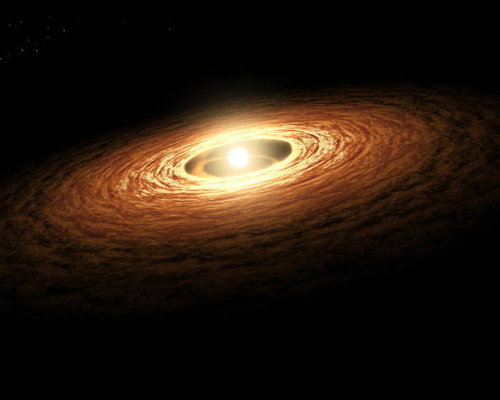
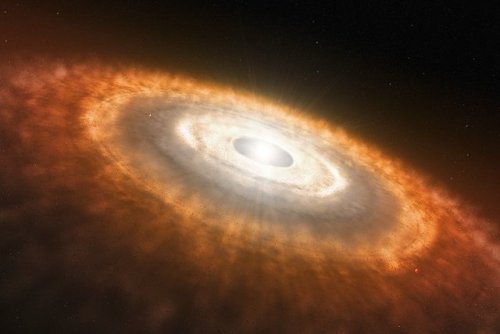
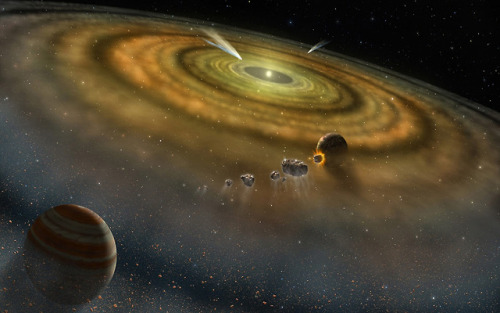
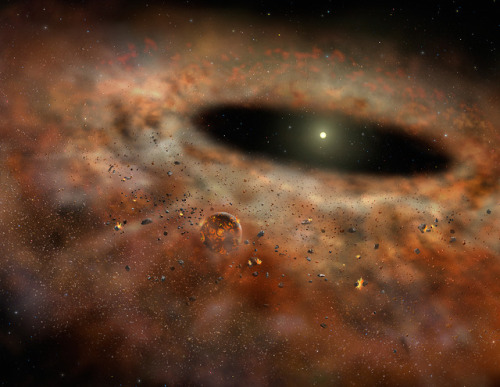
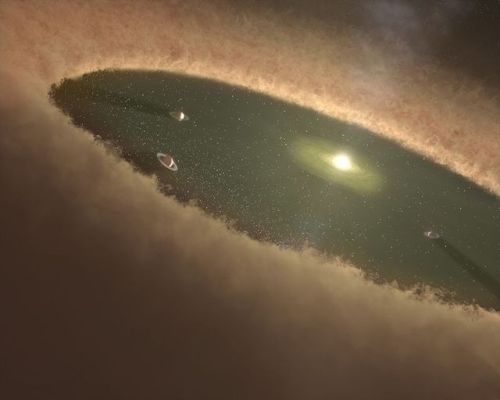
A protoplanetary disk is a rotating circumstellar disk of dense gas and dust surrounding a young newly formed star, a T Tauri star, or Herbig Ae/Be star. The protoplanetary disk may also be considered an accretion disk for the star itself, because gases or other material may be falling from the inner edge of the disk onto the surface of the star. This process should not be confused with the accretion process thought to build up the planets themselves. Externally illuminated photo-evaporating protoplanetary disks are called proplyds.
The nebular hypothesis of solar system formation describes how protoplanetary disks are thought to evolve into planetary systems. Electrostatic and gravitational interactions may cause the dust and ice grains in the disk to accrete into planetesimals. This process competes against the stellar wind, which drives the gas out of the system, and gravity (accretion), which pulls material into the central T Tauri star.
source
Image credit: NASA/JPL, ESO
More Posts from Monstrous-mind and Others
🌄🍁🍂🎃🍂🍁🐾🐈

🍁🍂🎃🍂🍁🌬🍃🐈🌄

Hello September. May you the first of so many good things to come as the unofficial start to autumn 🍂

By jayeffex
🍁🍂🎃🍂🍁🍃🐈📚📖☕
source
🐈🐏🐱🌄🍂🍁
“I woolly wuv your wool”
🐈🍂🍁🐾

@WeHeartIt /entry/27035659
🔭🌃🌌

Ocean on the moon Europa
Scientists' consensus is that a layer of liquid water exists beneath Europa's surface, and that heat from tidal flexing allows the subsurface ocean to remain liquid.

Europa's surface temperature averages about 110 K (−160 °C; −260 °F) at the equator and only 50 K (−220 °C; −370 °F) at the poles, keeping Europa's icy crust as hard as granite. The first hints of a subsurface ocean came from theoretical considerations of tidal heating (a consequence of Europa's slightly eccentric orbit and orbital resonance with the other Galilean moons). Galileo imaging team members argue for the existence of a subsurface ocean from analysis of Voyager and Galileo images.

The most dramatic example is "chaos terrain", a common feature on Europa's surface that some interpret as a region where the subsurface ocean has melted through the icy crust.
The thin-ice model suggests that Europa's ice shell may be only a few kilometers thick. However, most planetary scientists conclude that this model considers only those topmost layers of Europa's crust that behave elastically when affected by Jupiter's tides.

The Hubble Space Telescope acquired an image of Europa in 2012 that was interpreted to be a plume of water vapour erupting from near its south pole The image suggests the plume may be 200 km (120 mi) high, or more than 20 times the height of Mt. Everest.
Life?
So far, there is no evidence that life exists on Europa, but Europa has emerged as one of the most likely locations in the Solar System for potential habitability. Life could exist in its under-ice ocean, perhaps in an environment similar to Earth's deep-ocean hydrothermal vents. Even if Europa lacks volcanic hydrothermal activity, a 2016 NASA study found that Earth-like levels of hydrogen and oxygen could be produced through processes related to serpentinization and ice-derived oxidants, which do not directly involve volcanism.

In 2015, scientists announced that salt from a subsurface ocean may likely be coating some geological features on Europa, suggesting that the ocean is interacting with the seafloor. This may be important in determining if Europa could be habitable. The likely presence of liquid water in contact with Europa's rocky mantle has spurred calls to send a probe there.
Missions

Europa Clipper is an interplanetary mission in development by NASA comprising an orbiter. Set for a launch in October 2024, the spacecraft is being developed to study the Galilean moon Europa through a series of flybys while in orbit around Jupiter.

The Europa Lander is a proposed astrobiology mission concept by NASA to Europa, an icy moon of Jupiter. If funded and developed as a large strategic science mission, it would be launched in 2027 to complement the studies by the Europa Clipper orbiter mission and perform analyses on site. NASA's budget for fiscal year 2021 neither mandates nor allocates any funds to the mission leaving its future uncertain.
The objectives of the mission are to search for biosignatures at the subsurface ≈10 cm, to characterize the composition of non-ice near-subsurface material, and determine the proximity of liquid water and recently erupted material near the lander's location.
source

“If man had no eternal consciousness, if, at the bottom of everything, there were merely a wild seething force producing everything, both large and trifling, in the storm of dark passions, if the bottomless void that nothing can fill underlay all things, what would life be but despair?”
- Albert Camus, quoting Kierkegaard in “Sysiphos”
🎃🍂🍁🍂🎃🍂🍁🍂🎃🍃🐈🐾

🎃🍂🍁🐾🐈🐾🍁🍂🎃

🎃😻🍁 lena_fox_art 🎃😻🍁
-
 dragonflysrevenge liked this · 8 months ago
dragonflysrevenge liked this · 8 months ago -
 zurgy-space reblogged this · 11 months ago
zurgy-space reblogged this · 11 months ago -
 zurgy liked this · 11 months ago
zurgy liked this · 11 months ago -
 akaleilovesinspiration reblogged this · 11 months ago
akaleilovesinspiration reblogged this · 11 months ago -
 john-erby liked this · 11 months ago
john-erby liked this · 11 months ago -
 iamnotawomanartist liked this · 1 year ago
iamnotawomanartist liked this · 1 year ago -
 estefanyailen liked this · 1 year ago
estefanyailen liked this · 1 year ago -
 senlicandphycom liked this · 1 year ago
senlicandphycom liked this · 1 year ago -
 cohesin liked this · 1 year ago
cohesin liked this · 1 year ago -
 polyamoryinamsterdam liked this · 1 year ago
polyamoryinamsterdam liked this · 1 year ago -
 residenteevee liked this · 1 year ago
residenteevee liked this · 1 year ago -
 outsiderblues liked this · 1 year ago
outsiderblues liked this · 1 year ago -
 venusiansblog liked this · 2 years ago
venusiansblog liked this · 2 years ago -
 sdohi reblogged this · 2 years ago
sdohi reblogged this · 2 years ago -
 shantihtown reblogged this · 2 years ago
shantihtown reblogged this · 2 years ago -
 anderwhohn reblogged this · 2 years ago
anderwhohn reblogged this · 2 years ago -
 unibarth reblogged this · 2 years ago
unibarth reblogged this · 2 years ago -
 curious-and-learning liked this · 2 years ago
curious-and-learning liked this · 2 years ago -
 tui2--start reblogged this · 2 years ago
tui2--start reblogged this · 2 years ago -
 tui2--start liked this · 2 years ago
tui2--start liked this · 2 years ago -
 jeanjoel liked this · 2 years ago
jeanjoel liked this · 2 years ago -
 gutugutumakkan reblogged this · 2 years ago
gutugutumakkan reblogged this · 2 years ago -
 gutugutumakkan liked this · 2 years ago
gutugutumakkan liked this · 2 years ago -
 shortcutss reblogged this · 2 years ago
shortcutss reblogged this · 2 years ago -
 wolfinsheriffsclothing liked this · 2 years ago
wolfinsheriffsclothing liked this · 2 years ago -
 asheneclipse reblogged this · 2 years ago
asheneclipse reblogged this · 2 years ago -
 darkoverstar reblogged this · 2 years ago
darkoverstar reblogged this · 2 years ago -
 gravedangerahead reblogged this · 2 years ago
gravedangerahead reblogged this · 2 years ago -
 inkspill-nebula reblogged this · 2 years ago
inkspill-nebula reblogged this · 2 years ago -
 tattersby reblogged this · 2 years ago
tattersby reblogged this · 2 years ago
My ambition is handicapped by laziness. -C. Bukowski Me gustan las personas desesperadas con mentes rotas y destinos rotos. Están llenos de sorpresas y explosiones. -C. Bukowski. I love cats. Born in the early 80's, raised in the 90's. I like Nature, Autumn, books, landscapes, cold days, cloudy Windy days, space, Science, Paleontology, Biology, Astronomy, History, Social Sciences, Drawing, spending the night watching at the stars, Rick & Morty. I'm a lazy ass.
222 posts